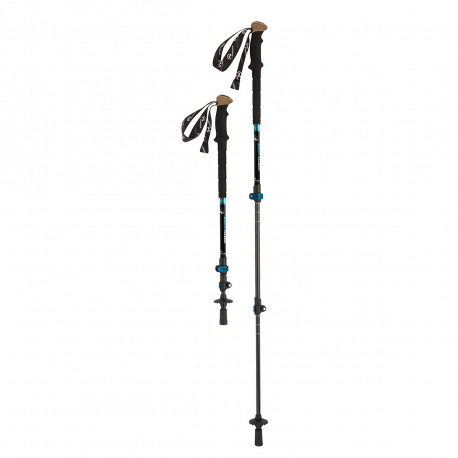How to choose and why use hiking poles?
Hiking or trekking poles are a terrific and proven aid for a one-day or several-day hike through the mountains. You will learn what benefits they bring you, what kinds of poles exist and how to use them, but mainly how to choose from the many available on the market. We can advise you, but you have to decide for yourself.


Why use poles?
- Stability – they help you maintain stability when climbing, descending or traversing and can help you distribute weight in the event of a heavy load.
- Support – the poles relieve the joints and muscles and reduce the possibility of injury on unstable surfaces.
- Complex movement and pace – thanks to the poles, you can also move the upper parts of your body, particularly the arms and shoulders. This in turn contributes to maintaining the pace of the hike even over longer distances.
- Practical use – they can serve, for example, in the construction of an emergency shelter, a tent, as a stabilizing splint for injuries, or help in clearing vegetation, when attacked by an animal and for safer crossing of streams or rivers.

Division according to construction
Folding poles
Folding poles – they are light and foldable and can be put away or unfolded in an instant. Most often this is a three-part construction of separate tubes connected to each other by a cable, but 4- or 5-piece constructions can also be found. The locking is ensured either by pulling the cable at the end of the handle, or by screwing, or by stretching and locking the telescopic part under the handle. The construction works with thin tubes – with feet of a smaller diameter than with telescopic poles. The aim is to minimize weight and storage. This is underlined by the use of ultralight, premium materials, but also by reduced resistance or the ability to face the consequences of careless handling.
If you decide for the lightest and simplest folding poles, pay increased attention to their length and construction as well as to the replaceability of the most stressed parts, such as the cable or joints. Depending on the materials used, the weight of a pair of poles can range from 240 g up to 650 g. Folding poles are popular with extreme athletes, the ski mountaineering public or terrain runners who can benefit most from their advantages.
Telescoping poles
Telescopic poles have a two-part or three-part construction of interlocking legs with locking in the joints. Their advantage is great versatility, variable length and durability. This type of pole is one of the best-selling, thanks to the good price-to-quality ratio. Beginners will enjoy themselves with occasional use of this category, but advanced users with more intensive commitment will do so, too. Telescopic poles have a more robust construction (larger tube diameters from 12 to 20 mm) than folding poles.
The locking mechanisms used to fix the length are an important element. Most poles today use a lever clip system – the so-called speed-lock – with which the length of the pole can be altered directly, easily and quickly on the go, even when wearing gloves. The twist-lock is a screw lock that is very strong and durable, but it is impractical when wet or when you are wearing gloves. Therefore, some manufacturers offer 3-piece poles with a quick-release lock in combination with fixed screw locking of the lower part.

What are you looking for and how do you decide?
- Low price – this doesn’t automatically mean that the poles are unusable. It can easily happen that branded, high-priced poles will not survive even the first trek. The price increases depending on the brand name, the material used or the technology of the lock. If you can accept a higher weight, i.e. thicker aluminium alloy tubes, a plastic lock, a rubber handle, the absence of replaceable plates or a lower quality tip, this is your category. And if you are a beginner or plan to use the poles only occasionally, you can save a relatively large amount of money here.
- Low weight – if you are looking for poles for intensive use in the field and larger transport dimensions don’t hinder you, choose two-piece poles made of aluminium alloy or folding 3-piece carbon poles with Spartan equipment. They have their price, but every gram counts. By the way, the lightest of them have already reached the limit of 240 g per pair. Comfort gets side-lined.
- Packability – be sure to choose 3- or 4-piece folding poles that upon packing can be reduced to less than 35 cm for some lengths and models. The typical size of telescopic poles is around 60 cm. Rubber bands for holding the poles together after folding are a perfect tool. You won’t save any money here and comfort doesn’t have to be completely taboo.
- Comfort – look for stable but also more robust poles made of aluminium alloys with an anti-shock system that absorbs the impact. Choose an anatomically shaped handle with a slant of up to 15 °, which fits perfectly in the palm of your hand. The best of quality foam or with a combination of cork and foam, or with anti-slip rubber parts.
Materials
The most common material for the production of the poles isan alloy of aluminium with zinc or aluminium with silicon and magnesium. The advantage of these alloys is their durability, low weight and relatively good flexibility.
Composite materials are known for their low weight and excellent shock absorption, but they are also brittle and break with even minor damage. New composite layering technologies are gradually balancing out this handicap, which is also reflected in their higher price.

Handles from foam, cork or rubber? You’ll mainly find rubber handles at the entry price level. The rubber has a higher weight and doesn’t absorb sweat, which can lead to blisters in summer and will degrade over time. In the winter, however, they’ll fulfil their duty well.
Synthetic polymer foams (ethylene-vinyl acetate, or EVA) of various shapes are durable and light; they absorb sweat and can be shaped, but best of all, they dampen vibrations. Combinations of foam handles with cork parts are common. Cork is also used independently. It is a light, anti-allergenic, water-repellent and shapable and at the same time more expensive material. Some claim that cork will crumble, while others say that you’ll recognize its benefits, especially in humid and cold weather. What can be added? Everyone is right.
The tips are made with cheaper variants of hardened steel poles, which have their limits and wear down or break faster. Tungsten carbide (WC), or simply a tungsten tip, is two-times harder than steel and even harder and denser than titanium. Its properties make it ideal for a very durable tip on poles for more demanding users.
The correct length of poles
The correct angle is the right length
The basic recommendation for setting the length of the poles is so that the upper arm forms a right angle with the forearm when holding them. You thus avoid pain in the back muscles or the cervical spine. With increasing experience with movement over the terrain, you can shorten the pole with a long ascent and slightly lengthen it when descending.
Try out the length of the poles directly when buying them. When shopping online, pay attention to the maximum adjustable size of the poles, which the seller should provide along with the transport length. Adjustable poles offer a wide range of settings. For fixed poles, you can choose only one of the offered dimensions.

| your height | minimum and maximum adjustable pole length |
| 155 - 175 | 100 cm - 125 cm |
| 175 – 185 | 100 cm - 125 cm |
| 185 – 195 | 110 cm - 135 cm |
| > 195 | 115 cm - 145 cm |
Every manufacturer has its own recommendations and can offer different lengths, so this table is for basic guidance only.
Tips:
- Comfort – the correct length of the poles, comfortable strap adjustment, or the use of a compact wrist strap clearly increase comfort. Impact on hard surfaces can be reduced by a built-in shock absorber together with moulded foam handles.
- Gloves – before use in the field, test the compatibility of the palm of the glove with the material and shape of the handle to prevent discomfort or unnecessary wear and tear.
- Plates or baskets – most manufacturers provide at least two sizes of replaceable plastic plates for the purchased poles. The larger is intended for winter hiking in the snow and the smaller plates about half the size are for summer hiking. The plates fix the pole on the snow surface and in summer reduce the chances of the tip slipping between stones.
- Care – you will extend the life of your poles if you clean them and dry them with a cloth immediately after returning from a hike. By releasing the locking points during storage, you reduce wear and prevent the plastic parts from breaking. Pay special attention to folding structures with a cable, according to the manufacturer's instructions. Store the poles in a dry, dark place with a constant temperature.
- Maintenance – never use lubricants based on friction for cleaning poles or locks. If the lock does not fulfil its function even after thorough cleaning, you can increase the friction of submerged aluminium sections by carefully sanding them with the finest sandpaper. We only recommend this, however, for poles out of warranty. Definitely avoid inserting any foreign fragments into the lock to increase its friction.
- Inspection of stressed parts – before each use, it is advisable to pay increased attention to the locking joints or inspection of cracks. If you find a crack, do not use the poles.
- Replacement – if the locks are cracked, oxidized or rusted, replace them with new ones.
- Warning: when buying poles, it is necessary to take into account their most common use. We do not recommend using telescopic hiking poles, for example, when skiing on the slopes. For Nordic walking, use only poles made by the manufacturer for this purpose.















